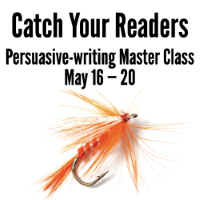Credit union communicator nails the feature structure
“Always grab the reader by the throat in the first paragraph,” said Time magazine reporter Paul O’Neil, “sink your thumbs into his windpipe in the second and hold him against the wall until the tag line.”

Writing structure — how you handle the first paragraph through the tagline — makes all the difference in how riveting your story can be.
Just ask Kathleen Sullivan, communication manager at Local Government Federal Credit Union.
During my Reach Readers Online Master Class, Kathleen reorganized a post step by step and wound up with a great blog. What can you learn from her before-and-after when writing blog posts?
1. Headline and deck.
At nine words, Kathleen’s original headline was a little long. It posed a question, which can make a good headline, but it wasn’t a question I felt a burning need to learn the answer to:
How does “emotional intelligence” influence your relationship with money?
For her rewrite, Kathleen added a deck, which allowed her to take some of the lead out of the lead. The resulting five-word headline made the story more provocative.
And the deck seems to be suggesting that I might learn something that would help me make or save money. I’m in!
Your love-hate relationship with money
Could Emotional Intelligence affect your finances?
2. Introduction
The introduction has three parts: the lead, the nut graph and the background section.
A. Lead. The job of the lead is to draw readers in.
In the original, Kathleen focuses on how the sausage was made … the abstract process behind the findings. Yaaaawn! Who cares about these interviews? Not me!
But Kathleen’s revision gets me, the reader, into the story. And I, like all of your readers, am my own favorite subject.
Moreover, she sets up a surprising scenario that grabs attention and pulls readers into the piece.
See the rest of the structure >>>
What structure draws more readers?
Writers say, “We use the inverted pyramid because readers stop reading after the first paragraph.” But in new research, readers say, “We stop reading after the first paragraph because you use the inverted pyramid.”
If the traditional news structure doesn’t work, how should we organize our messages?
Master a structure that’s been proven in the lab to outperform the traditional news format at Catch Your Readers, our persuasive-writing workshop, starting on May 16.
There, you’ll learn an organizing scheme that grabs readers’ attention, keeps it for the long haul and leaves a lasting impression.
Save up to $100 with our group discounts.
